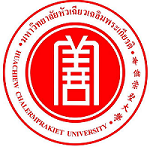Please use this identifier to cite or link to this item:
https://has.hcu.ac.th/jspui/handle/123456789/3708| Title: | Characterization of synthetic ecdysteroid analogues as functional mimics of brassinosteroids in plant growth |
| Authors: | Jutiporn Thussagunpanit Kanapol Jutamanee Sureeporn Homvisasevongsa Apichart Suksamrarn Ayumi Yamagami Takeshi Nakano Tadao Asami จุติภรณ์ ทัสสกุลพนิช คณพล จุฑามณี สุรีย์พร หอมวิเศษวงศา อภิชาต สุขสําราญ Kasetsart University. Faculty of Science Kasetsart University. Faculty of Science Huachiew Chalermprakiet University. Faculty of Science and Technology Ramkhamhaeng University. Faculty of Science RIKEN Center for Sustainable Research Science. Gene Discovery Research Group RIKEN Center for Sustainable Research Science. Gene Discovery Research Group King Abdulaziz University. Bioactive Natural Products Research Group |
| Keywords: | Brassinosteroids บราสสิโนสเตียรอยด์ Ecdysteroids เอคไดสเตียรอยด์ Growth (Plants) การเจริญเติบโตของพืช |
| Issue Date: | 2017 |
| Citation: | The Journal of Steroid Biochemistry and Molecular Biology 172 (September 2017) : 1-8 |
| Abstract: | Brassinosteroids (BRs) are plant steroidal hormones that play important roles in many stages of plant growth. Several plant species produce ecdysteroids, which are known as insect molting steroid hormones. In this study, we evaluated the biological activities of three hydroxysteroidal compounds, 20-hydroxyecdysone (ECD), 7,8-dihydro-8α-20-hydroxyecdysone (DHECD), and 7,8-dihydro-5α,8α-20-hydroxyecdysone (α-DHECD), and compared their activities with that of brassinolide (BL), the most potent BR. In rice, DHECD and α-DHECD enhanced the degree of lamina inclination, as do BRs. In Arabidopsis thaliana, DHECD and α-DHECD increased hypocotyl length in the wild-type, and also partially overcame the hypocotyl shortening in the wild-type caused by 0.3 μM brassinazole, a specific BR biosynthesis inhibitor. DHECD and α-DHECD partially reduced dwarfism in the BR-biosynthesis-deficient mutant det2. Treatment with DHECD or α-DHECD downregulated the expression of the BR biosynthesis genes DWF4 and CPD, which are generally, suppressed by BR, and upregulated the expression of TCH4 and SAUR-AC1, which are generally promoted by BR. However, their regulated activities were less effective than BL. Moreover, the 10−4 M DHECD and α-DHECD induced the accumulation of dephosphorylated BIL1/BZR1 that enhanced BR signaling as a master transcription factor. In contrast, ECD did not affect rice lamina bending, Arabidopsis hypocotyl elongation, the expression levels of BR-related genes and BIL1/BZR1 phosphorylation status. Based on these results, we hypothesize that both DHECD and α-DHECD have functional activities similar to those of BR. |
| Description: | สามารถเข้าถึงบทความฉบับเต็ม (Full Text) ได้ที่ : https://www.sciencedirect.com/science/article/abs/pii/S0960076017301279 The Journal of Steroid Biochemistry and Molecular Biology 172 (September 2017) : 1-8The Journal of Steroid Biochemistry and Molecular Biology 172 (September 2017) : 1-8The Journal of Steroid Biochemistry and Molecular Biology 172 (September 2017) : 1-8The Journal of Steroid Biochemistry and Molecular Biology 172 (September 2017) : 1-8 |
| URI: | https://has.hcu.ac.th/jspui/handle/123456789/3708 |
| Appears in Collections: | Science and Technology - Articles Journals |
Files in This Item:
| File | Description | Size | Format | |
|---|---|---|---|---|
| Characterization-of-synthetic-ecdysteroid-analogues-as-functional-mimics-of-brassinosteroids-in-plant-growth.pdf | 61.09 kB | Adobe PDF | View/Open |
Items in DSpace are protected by copyright, with all rights reserved, unless otherwise indicated.
